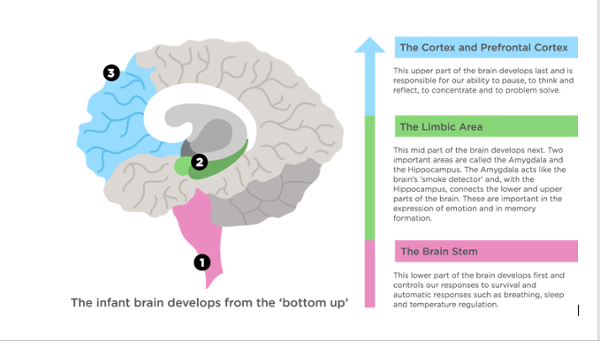Trauma and the brain
How trauma affects the developing brain:
Traumatic experiences in pregnancy and in the first 4 years of a child’s life can affect brain development and have a significant impact on later emotional, mental and physical wellbeing and the effects can persist into adult life.
The first 8 weeks of an infant’s life is especially vulnerable to the effects of traumatic experiences and especially to the effects of complex trauma.
Even more important than the experience of trauma is the presence of trusting, present, caring and safe adults (at the time of the trauma) who can protect and act as a buffer against the effects of the traumatic event(s).
When an infant, child or young person experiences or witnesses traumatic events that are life threatening or terrifying, the brain adapts in order to survive. Positive experiences with safe, nurturing and consistent adults can help with early brain development whilst negative experiences impair normal brain development.
Normal brain development:
In order to understand how trauma impacts on brain development it is helpful to understand how the infant brain develops. The brain can be divided into 3 areas and the brain develops from the ‘bottom up’:-
-
The Brainstem - This lower part of the brain develops first and controls our responses to survival and automatic responses such as breathing, sleep and temperature regulation.
-
The Limbic Area - This mid part of the brain develops next - 2 important areas are called the amygdala and the hippocampus. The amygdala is like the brain's "smoke detector" and plays an important role in the regulation of the emotions, memories and survival instincts. The hippocampus connects the lower and upper parts of the brain and is important in the expression of emotion and in memory function. When people response to real of perceived stress the hippocampus released a hormone called cortisol which helps regulate the response to stress.
-
The Cortex - This upper part of the brain develops last (that has been described as being like the brain's "watchtower") and is responsible for our ability to pause, to think and reflect, to concentrate and to problem solve. In particular an area called the prefrontal cortex works with the amygdala to regulate both emotions and behaviours.

Impact of trauma on the brain:
For a brain to work effectively all parts of the brain need to communicate from the bottom of the brain to the upper parts of the higher brain and also between the left and right side of the brain.
When the lower part of the brain responsible for survival is repeatedly activated and prolonged in infancy and in early childhood this can reduce the connections between other parts of the brain. This can significantly impact on our ability to learn, to form memories, to regulate emotions, it can affect our ability to be calm, to learn, to think, to reflect and to respond flexibly and in a planned way.
Research shows, for example, that adults with PTSD have a reduction in an area of their prefrontal cortex and a reduction in the volume of the hippocampus. In the absence of these regulatory mechanisms adults with PTSD may feel overwhelmed with stress and anxiety even in the absence of any real danger. Research also shows that adults with PTSD may have an increase in the activity of the amygdala (resulting in an increased startle response and more noradrenaline being released into the body).
The developing brain remembers traumatic events and abusive experiences, so that a survival response can be triggered even in the absence of danger. This can appear as flight, fight or freeze behaviours and responses. The traumatised lower brain tends to predominate and over time the brain can become more and more sensitised to real and perceived threat.
By knowing more about the neuroscience behind the changes in the brain resulting from trauma, this helps us understand and interpret infant’s, children and young people’s behaviours. It also helps guide young people, parents, Carers, Professionals and frontline workers in terms of what approaches and treatments are helpful, healing and effective.
Each and every contact with an infant, child or young person, no matter how brief, is a precious opportunity to impact positively on a child’s recovery and promote healing. There are multiple, daily opportunities to impact positively on a child or young person’s emotional wellbeing and to help build resilience and promote healing.
When and how to seek help:
It is important to know when to seek support and how to seek additional targeted or specialist support to aid with healing and recovery (see Getting Help tab for further information).